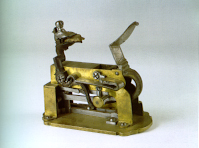
13 x 8.5 x 11.5
Bronze, steel and flint
INDEX 1788 : O.IV.297
Nova Machinula a me inventa, qua faciliori modo ostenditur ex Chalybe silici alliso in vacuo non excitari scintillas, nec pulverem pyrium, vel escam incendi. Componitur haec Machina ex lamina aenea ad latus perforata, cui insistit capsula quatuor veluti pedibus suffulta. Huic Capsula adnexa est catapulta illi similis quae adhibetur in Sclopetis. Super laminam sub pedibus capsulae datur regula dentata mobilis, quae ad extrema capita duos habet veluti vectes erectos, quorum ope catapulta oneratur, et exoneratur ad libitum, prout regula dextrorsum, aut sinistrorsum movetur. Cochlea firmatur machinula super Orbem Antliae Pneumaticae, operitur campana vitrea utrimque aperta. Operculum Campanae, quod est ex Orichalco, habet virgam aeneam oblongam satis crassam, quae permeat operculum, et inferius desinit in laternam dentatam. Laternae dentes congruunt cum regulae dentibus, ita ut virgam in Orbem volvendo, ipsa regula moto ad finitorem parallelo facile moveatur. Hoc modo, si exoneretur catapulta antequam aer extrahatur, conspiciuntur scintillae, quae non apparent, quando Campana est aere vacua.
A new little machine of my own invention by which is shown, in the easiest way, that striking a stone with steel in a vacuum does not kindle sparks, nor is the gunpowder or the chippings set alight. This machine is composed of a perforated bronze rod against which rests a box supported by four feet.
A catapult similar to that used on a short rifle is joined to this box. Over the rod, under the legs of the box, is a serrated, movable ruler that has two straight levers at the upper end with the help of which the catapult is loaded and fired at will, according to whether the ruler is moved to the left or to the right. The little machine is fixed with a screw above the disc of a pneumatic pump and is enclosed by a glass bell jar open on two sides. The cap of the bell jar, which is brass, has an elongated bronze spindle, quite thick, that crosses the cap and terminates further down in a serrated lantern-wheel. The teeth of the lantern wheel coincide with the teeth of the ruler in such a way that by inclining the spindle towards the disc the ruler moves easily by a movement parallel to the ends. In this way, if the catapult is fired before the air is extracted, sparks are seen that do not appear when the bell jar is empty of air.
This device is designed to demonstrate that air is necessary to ignite substances. It is especially interesting since it was invented by dalla Bella himself, according to the Index.
This device has a trigger that causes the production of sparks, using a piece of flint. The object was constructed to look like a four footed animal, with head and tail, when it is seen at a certain angle. The flint is installed in the animal's mouth whose head can be pushed backward, and fixed there, as in some types of shotgun. Thus the piece is armed. In order to activate the device, a button on the side is pressed, causing the flint to hit the metal plate in front of it, producing a spark.
The central part of the machine comprises a metallic box seated on four feet. Inside the box is a serrated horizontal ruler that can move to the right or the left, and does so when the gadget is prepared or fired.
This trigger was placed on the dish of the pneumatic machine and fixed by means of a screw, afterwards covering the dish with a bell jar open at the upper end. This opening was hermetically sealed with a brass lid pierced at the centre by a bronze rod, terminating internally in a serrated drum that was engaged by the teeth of the ruler referred to previously. It was possible to fire the gadget by turning the end of the rod (that had a handle on it) from outside the bell jar.
With everything in position as described above and the trigger armed, the air inside the bell jar was removed and the trigger released. It was seen that, owing to the vacuum in the jar, the impact of the flint on the metal plate did not produce any sparks.
From Colégio dos Nobres, catalogue n.º 287.Carvalho, Rómulo de, História do Gabinete de Física da Universidade de Coimbra, Universidade de Coimbra, Biblioteca Geral, Coimbra, 1978, pp. 459-460.